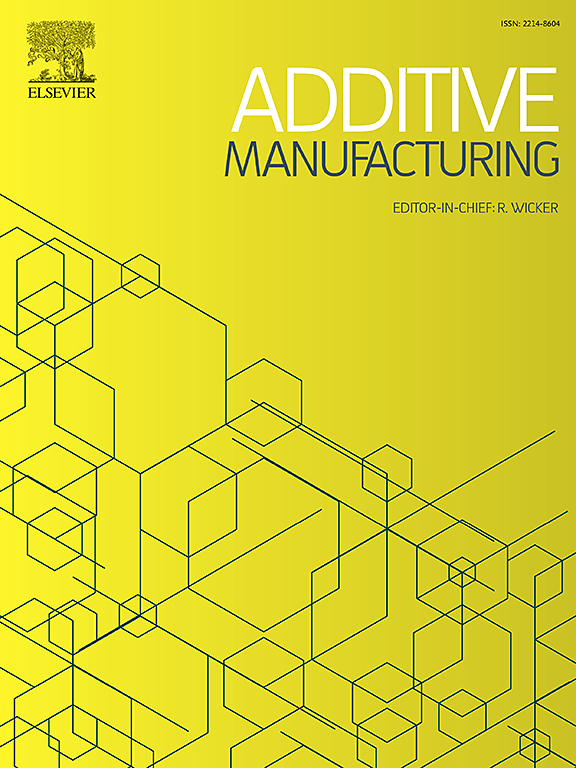利用LP-DED技术制备Ti-6Al-4V/C103功能梯度材料
IF 11.1
1区 工程技术
Q1 ENGINEERING, MANUFACTURING
引用次数: 0
摘要
本文研究了激光粉末定向能沉积(LP-DED)制备功能梯度Ti-6Al-4V-C103薄壁样品的制备和表征。薄壁通过三个不同的过渡步骤成功制造:100 wt%, 50 wt%和25 wt%。几何分析证明了打印保真度和一致的构建质量跨越实验设置。能谱仪验证了沿构建方向的成分梯度,而预期和测量的成分之间的差异归因于未熔化的C103颗粒的存在。定量分析表明,C103含量越高,未熔颗粒的面积分数越高。SEM和EBSD分析表明,随着C103的增加,组织结构由粗柱状向细等轴晶演变。枝晶宽度分析进一步表明,C103含量的增加导致分级沉积带内富ti区细化,富nb区粗化。显微硬度随组分的变化呈非线性趋势,25 wt% C103在425 HV时达到峰值,这可能是由于该梯度区域可能存在ω相,而进一步添加C103会导致整体显微硬度下降。本文章由计算机程序翻译,如有差异,请以英文原文为准。
Development and characterization of Ti-6Al-4V/C103 functionally graded material using LP-DED
This paper explores the fabrication and characterization of functionally graded Ti-6Al-4V–C103 thin wall specimens produced using Laser Powder Directed Energy Deposition (LP-DED). Thin walls were successfully manufactured with three distinct transition steps: 100 wt%, 50 wt%, and 25 wt%. Geometrical analysis demonstrated printing fidelity and consistent build quality across experimental setups. EDS validated the compositional gradients along the build direction, while discrepancies between expected and measured compositions were attributed to the presence of unmelted C103 particles. Quantitative analysis revealed that the area fraction of unmelted particles increased with higher C103 content. SEM and EBSD analyses revealed microstructural evolution from coarse columnar to finer equiaxed grains with increasing C103. Dendritic width analysis further revealed that increasing C103 content led to the refinement of Ti-rich regions and the coarsening of Nb-rich regions within the graded deposition zones. Microhardness measurements exhibited a nonlinear trend with composition, peaking at 425 HV for 25 wt% C103 potentially due to possible presence of ω-phase in this graded region, while further addition of C103 lead to a decrease on the overall microhardness.
求助全文
通过发布文献求助,成功后即可免费获取论文全文。
去求助
来源期刊

Additive manufacturing
Materials Science-General Materials Science
CiteScore
19.80
自引率
12.70%
发文量
648
审稿时长
35 days
期刊介绍:
Additive Manufacturing stands as a peer-reviewed journal dedicated to delivering high-quality research papers and reviews in the field of additive manufacturing, serving both academia and industry leaders. The journal's objective is to recognize the innovative essence of additive manufacturing and its diverse applications, providing a comprehensive overview of current developments and future prospects.
The transformative potential of additive manufacturing technologies in product design and manufacturing is poised to disrupt traditional approaches. In response to this paradigm shift, a distinctive and comprehensive publication outlet was essential. Additive Manufacturing fulfills this need, offering a platform for engineers, materials scientists, and practitioners across academia and various industries to document and share innovations in these evolving technologies.
 求助内容:
求助内容: 应助结果提醒方式:
应助结果提醒方式:


